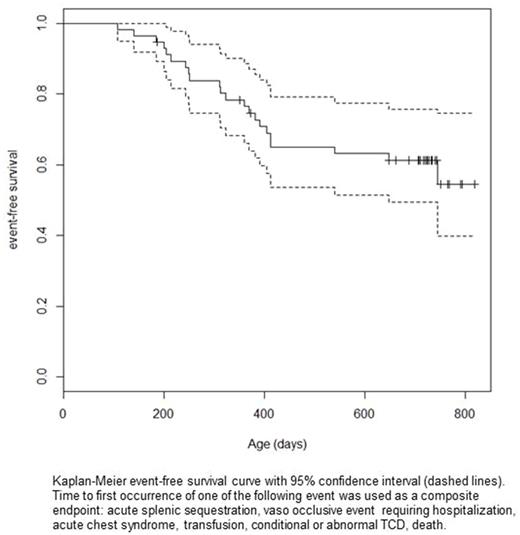Abstract
Background and hypothesis: Infancy is a critical time during which the first complications of sickle cell anemia (SCA) emerge. Very early prognostic factors of severity are needed to select high-risk children to offer precisely tailored therapy. Our hypothesis was that clinical, biological or genetic parameters measurable soon after birth (3 to 6 months of age) could predict severe outcomes in the first two years of life in SCA infants.
Methods: Infants with SCA were offered to participate in a prospective study (ClinicalTrials.gov: NCT01207037) that included clinical and laboratory assessment at enrollment (3-6 months) and at 12, 18 and 24 months of age. The prognostic performance of conventional and SCA-specific biomarkers (notably erythroid adhesion markers, dense cells, ektacytometry indices) on disease severity was assessed using Cox's proportional hazard regression models. The disease severity was defined as time to first occurrence of either acute splenic sequestration (ASS), vaso occlusive (VOC) event requiring hospitalization, transfusion, conditional or abnormal Trans Cranial Doppler, acute chest syndrome and death. Hazard ratios (HRs) were calculated with 95% Cis.
Results: Fifty-seven infants (55 SS; 2 Sβ°; 54.4% males), diagnosed through neonatal screening, were included in the study at a mean age of 4.4 ± 1 months and longitudinally assessed with a median follow-up of 19.4 months (range 3.1-23.2). Only 1 of 57 infants had experienced a SCA-related event prior to enrolment (dactilytis). At inclusion, clinical examinations were unremarkable except for pallor found in 15 (26,3%) and none of the infants had an enlarged or palpable spleen. Growth parameters were normal. Main biological characteristics were a mild hemolytic anemia (Hb 9.3 ±1.3 g/dL; reticulocytes count: 151.2 ±76 x 109/L), increased HbF level (3.8 ±1.3 g/dL. or 41.4 ±11.7%) and presence of dense red cells (23.1 % ±10.8). Genetic analysis showed one alpha globin deletion in 18 (32.1%) and a balanced distribution of beta globin haplotypes: 16 (30.8%), 18 (34.6%) and 18 (34.6%) in the favorable (SEN/SEN, BEN/SEN, CAM/SEN or SEN/ATYP), unfavorable (CAR/CAR, CAM/CAR, CAR/ATYP or BEN/CAR) and intermediate category (other) respectively.
During the 2 years duration of the study, 44 of 57 (77%) infants required 157 hospital admissions, median (range): 2 (1-12) per patient. Infection was a leading cause of hospitalization although no serious adverse event related to pneumococcal infection was noted. Eight (14%) children experienced an episode of ASS at a median (range) age of 13.4 months (7.8- 15.9) while 13 infants (22.8%) experienced at least one VOC event at a median age of 12.7 months (7-22.5), with 6 experiencing ≥ 2 episodes. Nineteen infants (33.3%) required at least one transfusion with 10 (17.6%) requiring more than 2. Altogether, 22 (38.6%) infants of this cohort experienced a SCA-related severe clinical event by 24 months of age. The Kaplan Meier estimate of the 24-month event-free rate was 54.4% (95% CI, 39.7 to 74.5%) (Figure).
Univariate analysis of potential prognostic markers at inclusion showed that higher HbF % and concentration were the strongest protective parameters for ASS in particular and for all severe outcomes, except for VOC (p < 0.001). Unfavorable haplotypes were also associated with severe outcome (HR (95% CI) 4.73 (1.31-17.01), p=0.017). Protective factors for VOC were higher Hb level (threshold > 8 g/dL) and low % of circulating dense cells (p=0.04 and 0.02, respectively). In a multivariate analysis, Hb level ≥ 8 g/dL and HbF ≥ 2.8 g/dL proved to be two independent prognostic factors of a SCA-related severe event (adjusted HRs (95% CI) 0.27 (0.11-0.73) and 0.16 (0.06-0.43) respectively). Interestingly, absolute neutrophil or reticulocyte counts, level of expression of known potentially pathogenic erythroid adhesion markers (CD36, Lu/B-CAM, ICAM-4/LW), % of red dense cell, or deformability parameters failed to be prognostic factors of specific complications or overall severity in this very young cohort.
Conclusion: HbF and Hb levels measured between 3 and 6 months of age in SCA infants predict the risk of subsequent severe clinical outcome in the next 2 years. These events are frequent even in a high-income setting where neonatal screening is implemented. These findings further support the early use of HbF inducers such as hydroxyurea in high-risk infants to sustain a protective HbF level.
Brousse: Add Medica: Membership on an entity's Board of Directors or advisory committees. De Montalembert: Novartis: Consultancy, Honoraria, Research Funding; Addmedica: Consultancy, Honoraria, Research Funding.
Author notes
Asterisk with author names denotes non-ASH members.


